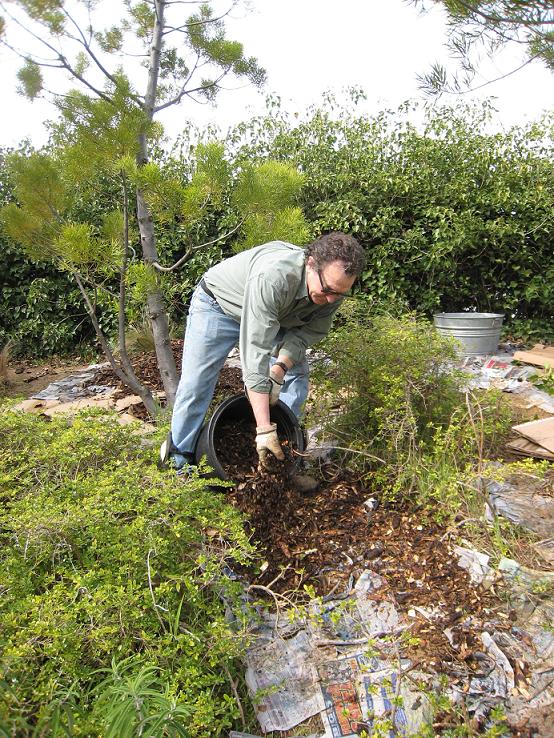.jpg) Fall Activities
Fall Activities

AS the cooler temperatures come your way, it becomes tempting to stay in-doors, and completely forget about your garden outside. In this article I would like to share some important things that you can do in your garden now, other than harvesting all your crops before a freeze comes, so that you’ll have a better one next year.
Prepare garden plots

Fall time is the perfect time to begin the preparation needed to make a new garden plot. You can simply do this by following the “lasagna” method. What is so fun about using this method is that the dead leaves and pine needles that are so abundant in the fall can be utilized. (Use them also for mulching!) Another fun aspect is that it requires no tilling or even weeding. Simply begin by covering the ground, even the weeds, with three layers of newspaper or one layer of corrugated cardboard. Wet this first layer well. This will ensure that the decomposition of materials will start. Next, make a thick layer of any of the following materials: leaves, pine needles, compost, shredded newspaper, grass clippings, manure, straw, or anything that you might throw in a compost pile (if using weeds, make sure they have not gone to seed), then keep adding layers until it’s height reaches about two feet tall. Also, the layers that are brown or dried out, like the leaves or shredded paper should be about twice as tall as the layers that are not, like the grass clippings or food scraps. The top, last layer should be of the brown materials. In the Spring dig in through the un-composted materials, and plant your seeds.
Planting
Certain root veggies (like beets, carrots, or radishes, and hardy greens like kale and other vegetables) can be started early in the Fall or in late Summer, and will last until a hard frost comes along. Garlic can be planted in the Fall. Flower bulbs like daffodils and tulips can be planted in mid Fall. In places with a mild winter, balled-and-burlapped or container-grown trees can be planted in early Fall, if care is taken that the root system is established before winter, and the tree is well taken care of. Bare root trees should only be planted in the late winter or early Spring, while the trees are still dormant.
Deep Watering
When the ground freezes, ground water is not available for the trees to utilize, so it is important if you live in a dry climate, to water trees and shrubs well, especially the newly planted ones.
Fertilizing
Fall is an excellent time to mulch. Mulching your garden beds during the fall will not only help to protect them during cold months, but will help to provide some fertilizer when once the warm months of spring arrive, and the moisture and warmth begin to break it down. Do this by covering the desired garden bed with a thick layer of mulch (preferably of differing sizes). A nice even layer of compost sprinkled over your lawn will also make for a healthier lawn in the Spring.
Cleaning
The last of all, but certainly not the least, is to clean. As we are all aware, by the end of the fall season there are tons of withered plants, fallen leaves, and pine needles all over the ground. In vegetable beds all traces of both plant and roots should be pulled up from the ground, and gathered onto a compost pile. Also make sure that around fruit trees all the fallen fruit is picked up from the ground. Doing this helps both the plants that will be planted in the spring and the trees from getting contaminated with any bugs like the apple maggot or any disease from the decaying organic matter, since it keeps disease and buggies from wintering over. Also, cut away any dead branches from perennials, bushes, trees, etc.
Things to do in the Winter
Pruning should take place in the dead of Winter, or when the trees and plants are just starting to bud in Spring. Pruning in the fall is debilitating to plants, because, during the Fall, plants are preparing for a dormant state, and trimming the limbs stimulates growth and activity, and makes them want to do the opposite. Thus, energy is needlessly spent by the plant, making it weaker.
Resources:
1. Lasagna Gardening, by Colleen Vanderlinden.
http://organicgardening.about.com/od/startinganorganicgarden/a/lasagnagarden.htm
2. What to Do In Your Garden This Fall to Get It Ready for Planting Next Spring, by Colleen Vanderlinden.
3. Fall Pruning: Don't Do It! by Leah Zerbe.
http://www.rodale.com/fall-pruning?page=0,0
Learn of what God says about looking within.
Gardening - Fall Activities
These are important things to do in your garden now!
The Lunar Sabbath Part 3 - The Divine Number
What is the purpose for numbers? And what does that have to do with the fourth commandment?
Health Corner - The Dangers of Supplements
You could be consuming something that you think is healthy, when it could be contributing to disease and even the very problem you are trying to avoid.
A Medical Missionary Academy
The Living Waters Medical Missionary Academy in Fiji opened its doors in the second semester of 2011... Find out more.
Recipe
Simply Yummy Pancakes
Think on These Things
An Addiction all Christians should have...
Seventh Day Home Church Fellowships is an association of Sabbath-keeping groups, which through web & tele-conferencing provides means for study, fellowship, and jointly organized missionary projects.
Website: www.seventhdayhomechurchfellowships.org
Email: admin@seventhdayhomechurchfellowships.org
Seventh Day Home Church Fellowships:
P.O. Box 262, Laconia, NH 03246, U.S.A.
